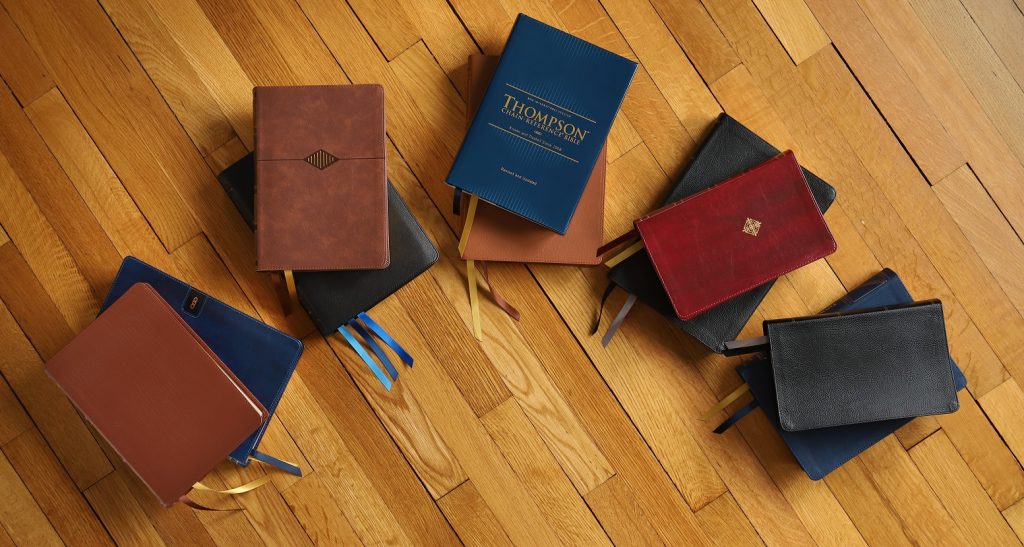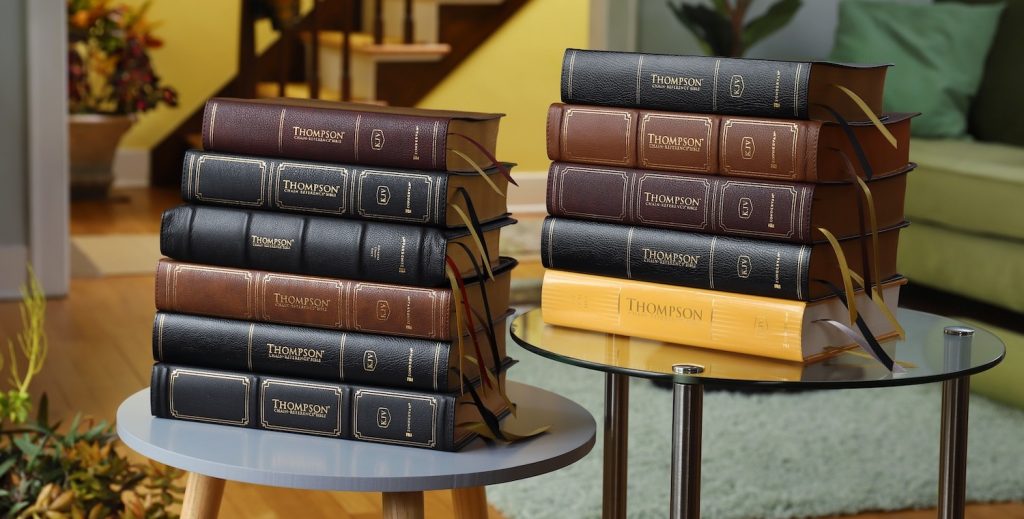The Thompson® Chain-Reference® Bible has been trusted and used for more than five generations. It is a study and reference work that is unparalleled in its ability to enrich personal devotions, topical study, and sermon preparation.
Why has it been so popular since its release in 1908? Because this unique reference Bible enables you to follow Scripture’s teachings on thousands of topics throughout the entire Bible. Its chain-reference system is an ideal tool for comprehensive topical study, with over 100,000 references that are listed in the Bible’s margins covering over 8,000 topics that span the entire Bible.
This Bible also offers a library of additional study resources that allows readers to interpret the Bible using related scripture passages rather than consulting other works, making this an all-in-one, self-contained study resource.

History of the Thompson Chain-Reference Bible
The Thompson Chain-Reference Bible is a beloved and time-tested reference work that was the lifetime labor of Bible scholar, minister, and teacher Dr. Frank Charles Thompson. Dr. Thompson received his Ph.D. from Boston University and began his ministry in a Methodist church in western New York in the late 1800s.
Early in his ministry, Dr. Thompson realized that the reference Bibles then on the market failed to help students of the Bible organize their study in a clear, scholarly, interesting, and yet simple and compact form. He saw the need for a well-organized reference Bible that both laypersons and ministry professionals could use.
Dr. Thompson began his original research about 1890. He was a deep Hebrew, Aramaic, and Greek scholar, and he referred to the original manuscripts for many of the thoughts he placed in the margins of his wide-margin King James Version Bible.
Over time and through four generations of family, the curators of the Thompson Chain-Reference Bible at B.B. Kirkbride and Company worked with other English and global-languages publishers to release the notes and study helps in various Bible editions. Their work included partnering with then family-owned Zondervan Bible Publishers to release the first NIV edition in 1983, with other editions to follow in multiple languages. In 2020, the Thompson Chain-Reference Bible assets were sold to Zondervan for their ongoing stewardship of this important Bible resource.
Zondervan continues to honor the long and excellent publishing tradition of the Thompson Chain-Reference Bible. The goal of the Zondervan Bible Group is to continue the legacy of in-depth study and learning begun by Dr. Thompson with the first edition in 1908, bringing these excellent, in-depth reference tools in new fonts, formats, and translations to readers in the 21st century.
New Vision, New Century, New Editions
Work began in 2021 to create a brand-new edition of the TCR. With access to the latest technologies, the team that worked on the NIV Thompson Chain-Reference Bible was able to create a new edition that has unparalleled accuracy and that is absolutely complete in its essence.
What’s more, the composition team used the NIV Comfort Print® font, specifically created for the NIV translation by a globally renowned team in Denmark to be efficient, beautiful, and very easy to read. Different fonts were also carefully curated for the KJV, NKJV, and NASB translations. These fonts reflect the history, character, and flavor of each specific translation.
When Zondervan considered the release strategy of the new editions, they wanted to make the Thompson Chain-Reference Bible as accessible to multiple audiences as it had been in the past. They began with data brought over from the original editions; data that had long been built on the foundation of Thompson’s original notes—built by hand and checked by hand. That system had produced the wonderful editions available in the past, but a new system was required to update the Thompson Chain-Reference Bible for additional modern Bible translations.
In partnership with various outside organizations that had past experience with integrating the TCR notes and indexes into scholarly electronic products, the team was able to complete a comprehensive comparison and review of all of the notes so that the latest edition of the TCR represents the highest order of accuracy. All of the marginal notes have references in the Alphabetical and Numerical Indexes of Topics, and vice-versa, which had not necessarily been true in the past.

Multiple Audiences, Multiple Translations
Part of bringing the Thompson Chain-Reference Bible into the 21st century, after all the improvements were made, was to pursue a translation strategy that addressed the needs of multiple audiences so that readers could find the excellent resources of the TCR in their translation of choice. That’s why there are new TCR editions in the NIV, KJV, and NKJV, with the NASB and ESV translations on the way.
To execute this strategy, the data for the study tools of the TCR, in each of its iterations, was carefully checked and changed to match the different translational nuances. Zondervan used the improved data that went into the NIV as the foundation for bringing the TCR into all of the other translations.
For this to happen, the team that had carefully analyzed all of the data in the study system also compared that data against the specific nuances of each of the translations named above. Those suggested changes were comprehensively checked and re-checked by Zondervan staff, and as the changes were integrated into that translation’s database, new translation-specific notes databases were developed.
These new databases factor in such translation differences as word choice, variations in spellings (e.g., Abed-nego vs Abednego), differences in terminology (e.g., Festival of Tabernacles vs Feast of Booths), and thousands of other nuances of each translation. All of these changes are reflected in the marginal reference notes, with some exceptions where spelling and terminology remain consistent over the various translations. In these instances, sometimes the most descriptive term was retained to assist the reader in understanding (e.g., retaining “sapphire” to describe a blue jewel instead of using “lapis lazuli”).

The Alphabetical and Numerical Indexes of Topics
However, the biggest job in carrying out this multi-translation strategy, as any TCR user can imagine, involved making all of the translation-specific changes to the front and end matter features—specifically, the Alphabetical and Numerical Indexes of Topics, where literally thousands of verses are written out in their entirety for ease of use by TCR readers.
What in the past had taken months and involved painstaking work (with the potential for human error as eyes grew tired and fingers fumbled on the mouse and keyboard) became a relatively simple task for our team of data analysts. These talented individuals, equipped with the correct tools, were able to replace the text of the translation in these massive indexes with the new translations in a matter of hours rather than months. What’s more, they were able to confirm that all of these printed verses were correct using up-to-the-minute verification software.
The end result is a clean, updated design with beautiful font selections in multiple translations for multiple audiences.
As these wide-ranging translation editions release, it is our sincere hope that readers will come to love and profitably use the notes of the TCR in their translation(s) of choice.
The post The Thompson® Chain-Reference® Bible: Multiple Translations for Multiple Audiences appeared first on Bible Gateway Blog.









